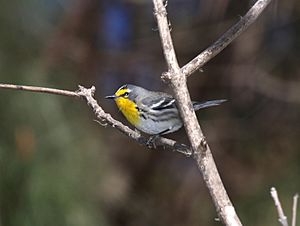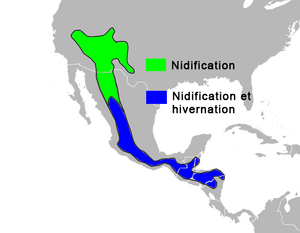Grace's warbler facts for kids
Quick facts for kids Grace's warbler |
|
|---|---|
 |
|
| Conservation status | |
| Scientific classification | |
| Genus: |
Setophaga
|
| Species: |
graciae
|
 |
|
| Synonyms | |
|
|
The Grace's warbler (Setophaga graciae) is a small New World warbler. This bird loves to live in pine forests.
Contents
Discovering Grace's Warbler
A scientist named Elliott Coues found Grace's warbler in the Rocky Mountains in 1864. He wanted to name this new bird after his 18-year-old sister, Grace Darling Coues. His wish came true! Another scientist, Spencer Fullerton Baird, officially described the bird in 1865. He gave it the name Grace's warbler.
What Does Grace's Warbler Look Like?
Grace's warbler is a small bird, about 11 to 13 centimeters long. That's about the length of your hand! Its back is mostly gray. It has some broken black stripes on its back and sides. Its wings have two white bars.
The throat and chest of this bird are a bright yellow. The rest of its belly is white. It also has a yellow half-ring under its eye. A long yellow stripe, like an "eyebrow," starts at its beak. This stripe goes above its eye and then turns white.
Where Does Grace's Warbler Live?
Grace's warblers make their homes from the southwestern United States all the way to Nicaragua. They spend their winters in these same areas. You will almost always find them in pine forests. Even when they are migrating, they stick to pine trees.
In some northern areas, like southern Nevada and Utah, they might live in spruce and fir forests. They like open forests that look like parks. In places like northern Arizona, they often prefer areas with Gambel's oak trees.
In the United States and northern Mexico, they usually live at high places. This is between 1,800 and 2,700 meters high. Farther south, they can live as low as 250 meters. In some parts of Nicaragua, where only Caribbean pine trees grow, Grace's warblers might be the only birds you see!
Behaviour and Ecology
Grace's Warbler Reproduction
We don't know much about how Grace's warblers build their nests. This is because their nests are very hard to find! The nest is a neat cup made of plant fibers. Inside, it's lined with hair and feathers. They place their nests high up on a tree branch, usually a pine tree.
The female bird lays 3 to 5 eggs. The eggs are white or cream-colored. They have brown speckles and a ring of spots at the wider end.
What Does Grace's Warbler Eat?
Grace's warblers mainly eat insects and spiders. This is true for most warblers. They mostly look for food high up in pine trees. One study in Arizona showed they spent 86% of their time foraging in pines.
They catch their food from the bottom of needle groups. They also find food on the upper bark of branches. These branches are usually no thicker than the bird's body. They often hover in the air to check pine cones for insect larvae. In Arizona, they don't often fly to catch insects. But in Nicaragua, they do this more often.
See also
 In Spanish: Reinita de Grace para niños
In Spanish: Reinita de Grace para niños


